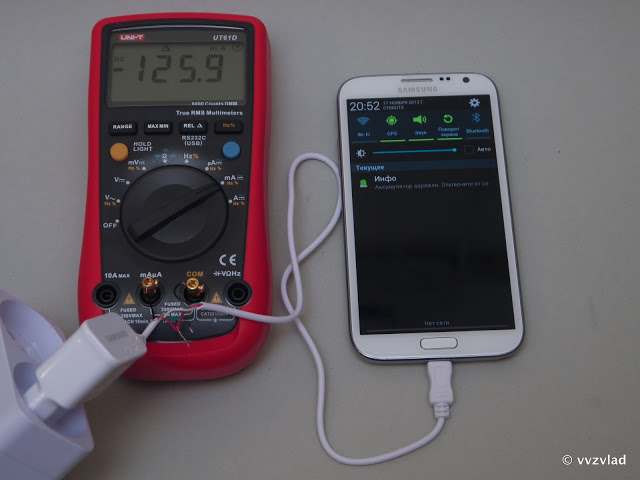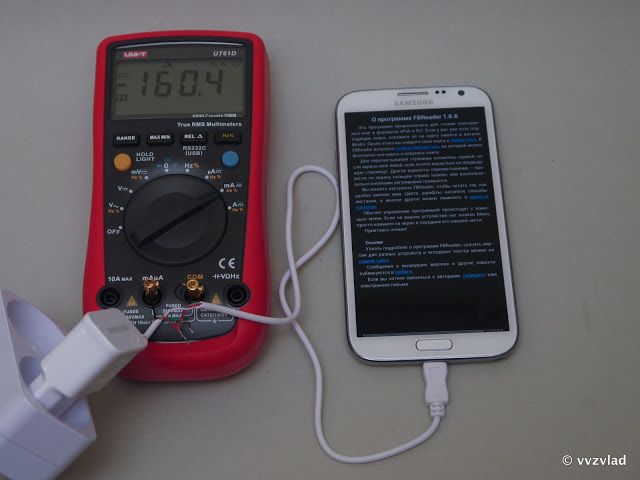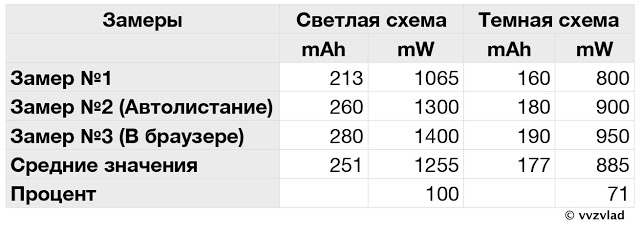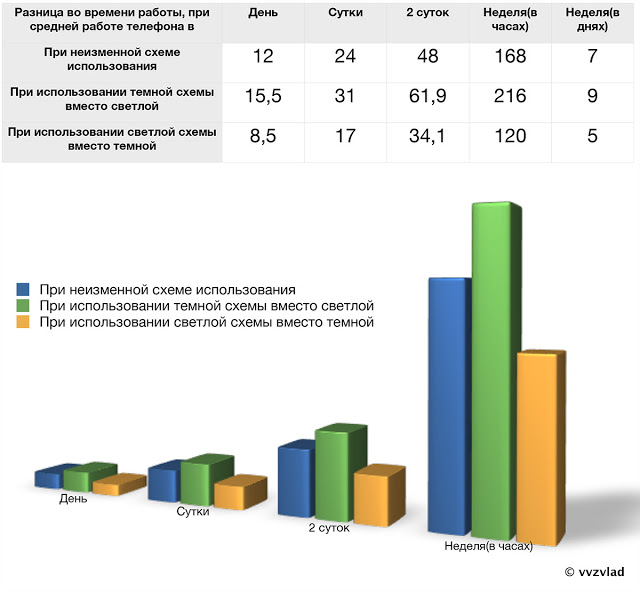Moving to the dark side: energy efficiency of dark circuits on AMOLED displays
It was interesting to me how justified the advice is to use dark screen schemes to save energy on AMOLED displays. No, there was no doubt that it consumes less - once the screen pixels are lit less, then the energy should consume less. But how many times, is it necessary to endure the inconvenience, or is the savings insignificant? I quickly put together such a test stand:

As the test was used already familiar Galaxy Note II.
I was planning to connect to the battery, but it turned out that the multimeter breaks the circuit when changing the measurement limits, and the phone turns off. I had to plug into the break in the power cord. Given that the battery was fully charged, and the current when the phone was turned off was almost zero, it did not affect the measurement results (I hope).
A little information. Amoled-displays (Active Matrix Organic Light-Emitting Diode - Active Matrix on Organic LEDs) differs from conventional LCD screens in that it does not have the usual backlight and “opening” pixels to skip the desired light. It can be compared with the LED display, where there are only LEDs of three colors that directly form the image, lighting up in the right places.
While in the LCD displays, the backlight works constantly, regardless of whether the pixels are “open” or “closed” (they let all the light from the backlight on or hold most of it), in the AMOLED displays, the LEDs in the black areas of the screen simply do not light up, and thus do not consume energy.
My task is to find out whether there is a big difference in the screen power consumption in dark schemes (where there is a dark background, but white letters and interface elements) and light (where there is a light background, but dark letters).
Let's start.
Phone Samsung Galaxy Note II, the display of which I have already shown in the previous topic, but will show again:

When off, consumed 10mA. We assume that this is the current consumption of the converter for charging the battery and related equipment.

We switch the multimeter to the delta mode, in which it shows only the difference between the current consumption and the recorded in memory. Thus, he will deduct 10mA from all readings. This can be done manually, but I'm playing with a new multimeter.

We took the quiescent current (phone consumption in the off state) for 0. Press the power button:

When loading, the current varies significantly - from 100mA to 500. I managed to catch the value of 223mA.
After a full load, the current has changed down:

180mA. It should be borne in mind that this is not the full brightness. Go to the desktop and the current rises to 213:

Go to the menu (it just has a dark interface):

Oops. 126mA. A bit uncorrect. In order to find out for sure - you need to find a black and white picture, and then invert it. I did it in the book reader, I think this is the most correct testing - not so much affect the CPU load, and most of the energy consumption falls on the screen. Enough words!
Light theme (day mode):

Dark theme (night mode):

The difference is 160mA and 213mA. Let's take a couple of measurements, and put the results into a table.

However, a saving of 30%. Let us estimate how this will affect the time of the phone:

The line “When using a dark scheme instead of a light one” shows the change in the operating time relative to your normal time that the battery takes when switching from light to dark. Let's say your spherical phone lives a day without charging, and uses a light scheme. Switching to the dark, you will not have 24 hours of work, but 31 :)
And if you are tired of rape your eyes, and you turn on the light scheme, instead of the default dark one, your phone will sit for 14 hours instead of the usual 24. This can be seen in the line “When using the light scheme instead of the dark one”
Of course, this estimate is very incorrect - it does not take into account either the consumption of the processor, or the radio interfaces, or different colors in the programs. Still, it shows the difference between dark and light schemes - it is more than noticeable.
')
As usual, you can subscribe to me (in order not to miss new articles) in my profile (the "subscribe" button)

As the test was used already familiar Galaxy Note II.
I was planning to connect to the battery, but it turned out that the multimeter breaks the circuit when changing the measurement limits, and the phone turns off. I had to plug into the break in the power cord. Given that the battery was fully charged, and the current when the phone was turned off was almost zero, it did not affect the measurement results (I hope).
A little information. Amoled-displays (Active Matrix Organic Light-Emitting Diode - Active Matrix on Organic LEDs) differs from conventional LCD screens in that it does not have the usual backlight and “opening” pixels to skip the desired light. It can be compared with the LED display, where there are only LEDs of three colors that directly form the image, lighting up in the right places.
While in the LCD displays, the backlight works constantly, regardless of whether the pixels are “open” or “closed” (they let all the light from the backlight on or hold most of it), in the AMOLED displays, the LEDs in the black areas of the screen simply do not light up, and thus do not consume energy.
My task is to find out whether there is a big difference in the screen power consumption in dark schemes (where there is a dark background, but white letters and interface elements) and light (where there is a light background, but dark letters).
Let's start.
Phone Samsung Galaxy Note II, the display of which I have already shown in the previous topic, but will show again:

When off, consumed 10mA. We assume that this is the current consumption of the converter for charging the battery and related equipment.

We switch the multimeter to the delta mode, in which it shows only the difference between the current consumption and the recorded in memory. Thus, he will deduct 10mA from all readings. This can be done manually, but I'm playing with a new multimeter.

We took the quiescent current (phone consumption in the off state) for 0. Press the power button:

When loading, the current varies significantly - from 100mA to 500. I managed to catch the value of 223mA.
After a full load, the current has changed down:

180mA. It should be borne in mind that this is not the full brightness. Go to the desktop and the current rises to 213:

Go to the menu (it just has a dark interface):

Oops. 126mA. A bit uncorrect. In order to find out for sure - you need to find a black and white picture, and then invert it. I did it in the book reader, I think this is the most correct testing - not so much affect the CPU load, and most of the energy consumption falls on the screen. Enough words!
Light theme (day mode):

Dark theme (night mode):

The difference is 160mA and 213mA. Let's take a couple of measurements, and put the results into a table.

However, a saving of 30%. Let us estimate how this will affect the time of the phone:

The line “When using a dark scheme instead of a light one” shows the change in the operating time relative to your normal time that the battery takes when switching from light to dark. Let's say your spherical phone lives a day without charging, and uses a light scheme. Switching to the dark, you will not have 24 hours of work, but 31 :)
And if you are tired of rape your eyes, and you turn on the light scheme, instead of the default dark one, your phone will sit for 14 hours instead of the usual 24. This can be seen in the line “When using the light scheme instead of the dark one”
Of course, this estimate is very incorrect - it does not take into account either the consumption of the processor, or the radio interfaces, or different colors in the programs. Still, it shows the difference between dark and light schemes - it is more than noticeable.
')
As usual, you can subscribe to me (in order not to miss new articles) in my profile (the "subscribe" button)
Source: https://habr.com/ru/post/161559/
All Articles